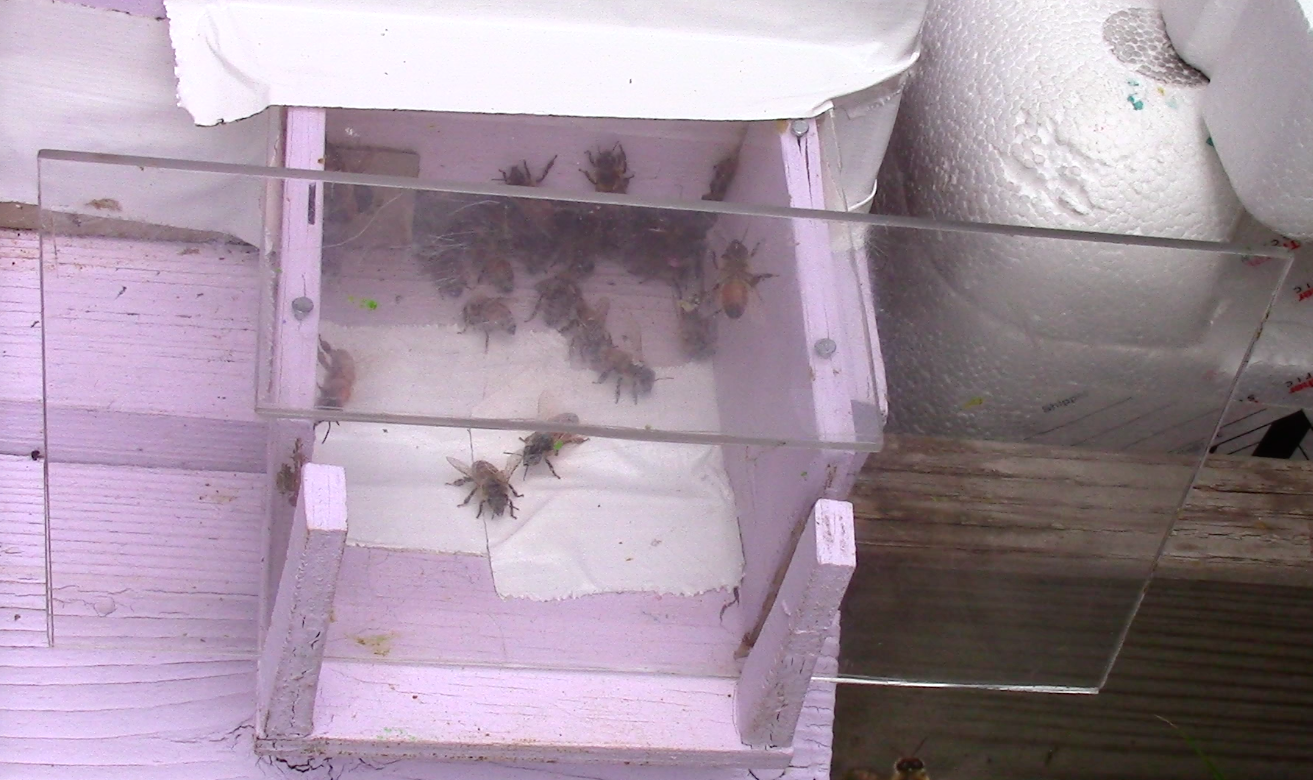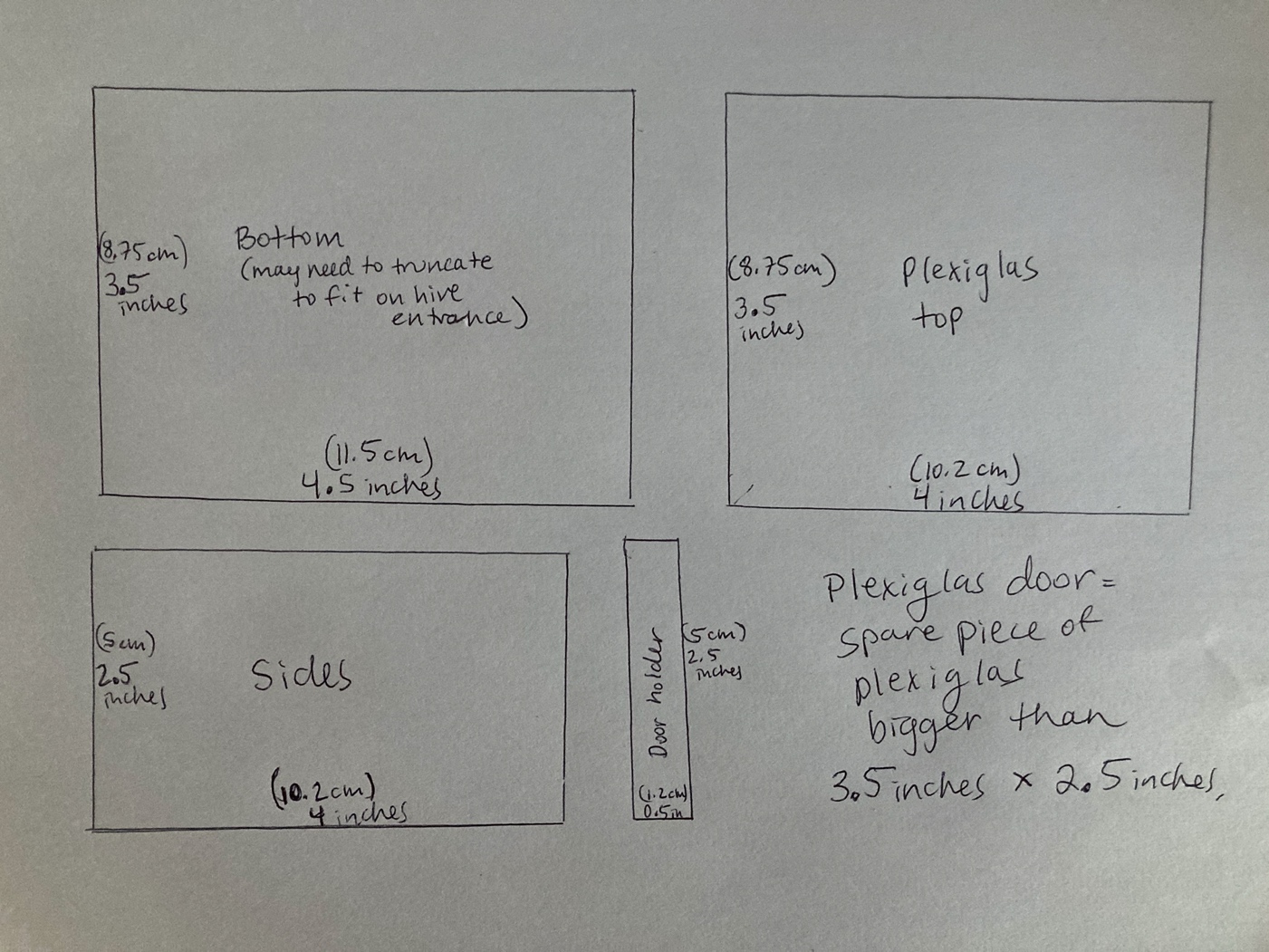Nestmate Recognition Assay
Supplies
- Wooden platforms (see schematic)
- 15 mL conical tubes (Millipore Sigma CLS430791) with 4 holes poked in each cap
- Colored paint (Testor’s Enamel paint)
- Forceps
- Wet ice in a Styrofoam cooler
- Camera and tripod (if video recording)
Protocol
Note: The best conditions to perform these assay are on sunny, warm days (at least 70°F/21°C) from 10am -3pm.
- Build wooden platforms using ¼ inch thick plywood and 1/8 inch thick Plexiglas. See my schematic below.
- Using duct tape, affix the platform to one side of the hive entrance at least a week before the assays, so that the bees get used to using the platform as an entrance. Block the remainder of the hive entrance using an entrance reducer. Leave the door off of the platform during this time.
- The day of the assay, chill the bees to be used as intruders on wet ice until they are immobile and place a spot of paint on each thorax.
- Place each bee into individual 15 mL conical tubes with holes poked in their caps.
- Blind yourself to each trial. I usually have someone else randomly label each tube with a trial number and write down what each one is.
- Keep the conical tubes on wet ice in a Styrofoam cooler. It is suggested to put a layer of cardboard between the tubes and the ice to avoid freezing the bees.
- Set up the camera and begin recording.
- Pull out the first 3 tubes containing bees for trials 1-3 and allow to warm up until the bees begin to walk around.
- Carefully open the trial 1 tube and place it horizontally on the platform with the opening facing the entrance of the hive. Allow the bee to crawl out and quickly remove the tube.
- Quickly place the Plexiglas door on the platform to “trap” the bee in the platform. Oftentimes, the bee will move toward the exit rather than going into the colony, so this door is needed to ensure the bee stays within the area where it can be seen and approached by the guards. It is best to have the door prepared to immediately put it in place when you remove the tube.
- Allow the bee to remain on the platform for 5 minutes. The bee should be approached by guards. Bees are considered ‘rejected’ if they are bit, stung and/or dragged by at least one guard bee. Bees are considered ‘accepted’ if they are approached by guards, antennated and/or licked and then left alone (not bit), if they immediately entered the colony and were not removed by other bees, or if they remained on the platform and did not receive aggression.
- After 5 min, if the focal bee remains on the platform outside the colony, remove them using forceps. If it went into the hive, you will not be able to retrieve it.
- Wait 5 minutes before beginning the next trial.
- Pull another tube out of the cooler, so that you have 3 tubes out of the cooler.
- Begin trial 2.


Copyright: Content may be subjected to copyright.
How to cite:Readers should cite both the Bio-protocol preprint and the original research article where this protocol was used:
- Vernier, C(2020). Nestmate recognition assay. Bio-protocol Preprint. bio-protocol.org/prep545.
- Vernier, C. L., Krupp, J. J., Marcus, K., Hefetz, A., Levine, J. D. and Ben-Shahar, Y.(2019). The cuticular hydrocarbon profiles of honey bee workers develop via a socially-modulated innate process. eLife. DOI: 10.7554/eLife.41855
Do you have any questions about this protocol?
Post your question to gather feedback from the community. We will also invite the authors of this
article to respond.
 Post a Question
Post a Question0 Q&A


